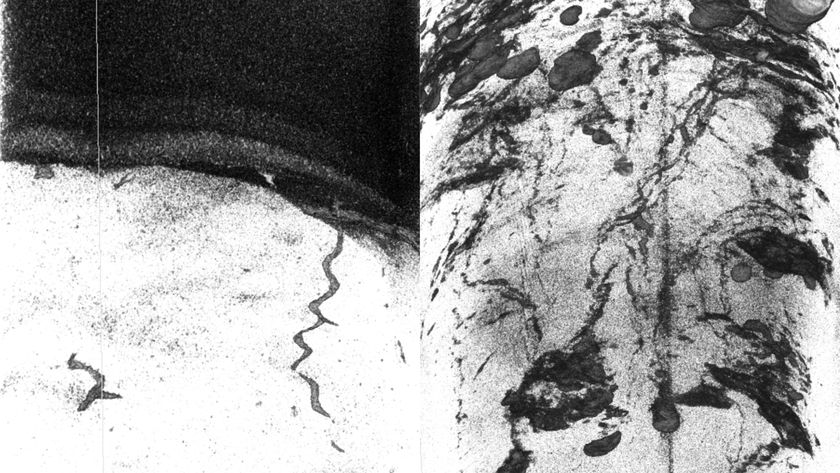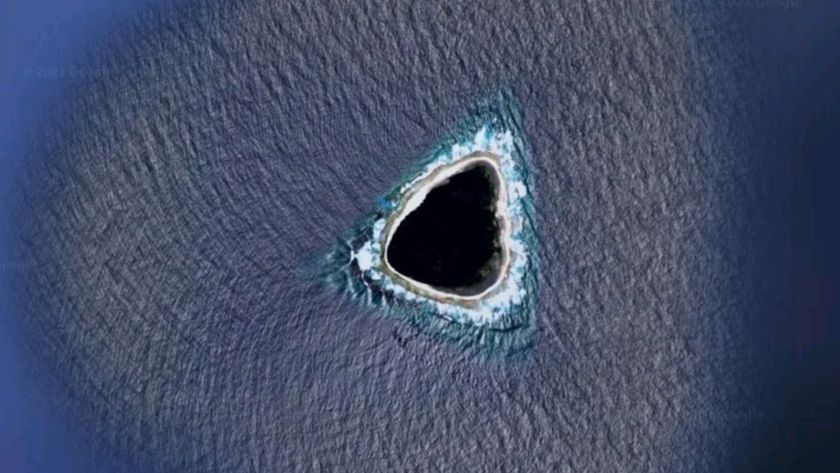Missing Flight MH370: Ocean Currents Point to New Search Spot
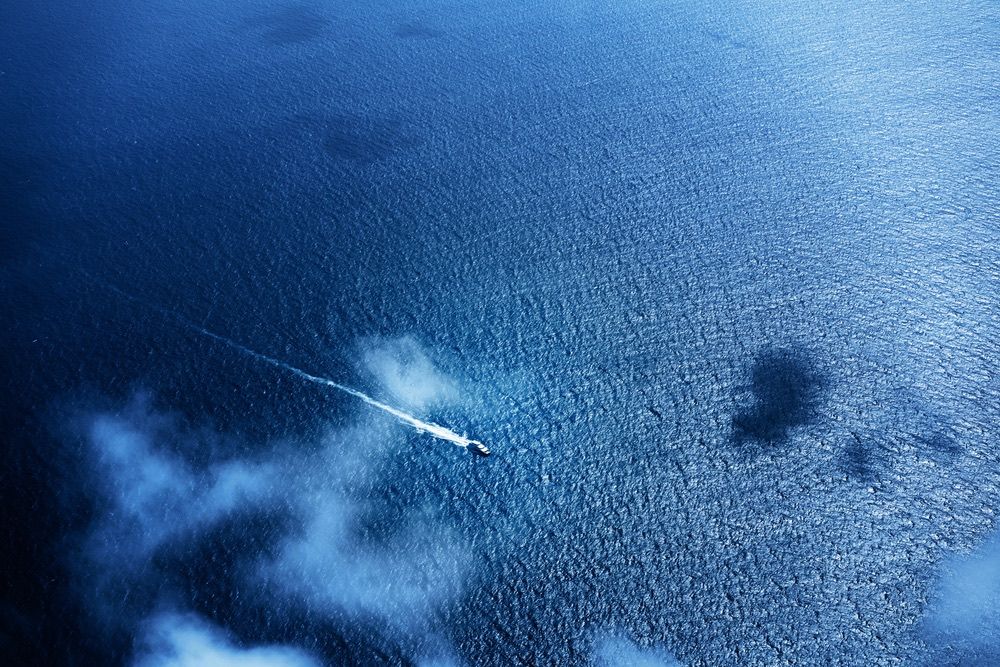
The disappearance of Malaysia Airlines flight MH370 is one of the greatest mysteries in aviation. Costing A$180 million, the search of the seabed to locate the crash site is also one of the most expensive.
But after almost 28 months since its disappearance, the exact crash location has still not been found.
The Australian government, with help from experts from Malaysia and China, has been coordinating the search effort over a 120,000 square kilometre area of the Indian Ocean, off Western Australia.
With just 10,000 square kilometres still to be searched, senior ministers from the three countries met earlier this month to consider what to do if they find nothing.
The current plan is to suspend the search – not abandon it – in case any “credible new information” should emerge that could be used to identify the specific location of the aircraft.
What do we know so far
Flight MH370 disappeared on March 8 2014, en route from Kuala Lumpur, in Malaysia, to Beijing, in China, with 239 passengers and crew on board. For reasons that are still unknown, the aircraft diverted from its scheduled flight path.
The main evidence on the flight path of the aircraft was provided through satellite data obtained from Inmarsat, which indicated that the plane most likely ended up in the southeast Indian Ocean.
Sign up for the Live Science daily newsletter now
Get the world’s most fascinating discoveries delivered straight to your inbox.
Analysis of a series of seven acoustic “pings”, originating from the aircraft engines, showed the likely location of the plane was along an arc that allowed for an equidistance between the plane and the satellite.
The last of the seven pings was received at 00.19 UTC and the location of this arc – the 7th arc – is the basis for defining the search areas by the Australian Air Transport Safety Board (ATSB).
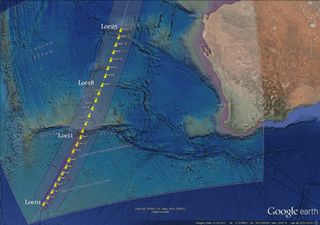
The oceans around the potential crash area were extensively searched using ships and aircraft in the days and weeks after March 18 2014, but they failed to identify any surface debris.
The aircraft debris
On July 29 2015, more than 16 months after the flight disappeared, a section of a wing – a flaperon – washed up on Reunion Island in the eastern Indian Ocean. This was later confirmed as originating from the MH370 aircraft.
We actually predicted this discovery using an oceanographic drift model 12 months in advance.
Subsequent to finding of the flaperon on Reunion Island, additional pieces of debris have been found in the eastern Indian Ocean along the shorelines of Mozambique, South Africa, Madagascar and Tanzania. These, too, are consistent with our drift modelling predictions.
In addition, the discoveries by US lawyer and amateur investigator Blaine Gibson were facilitated by the model predictions we made.
There are many clues that a knowledge of the oceanographic processes and drift modelling provide to this mystery.
First, due to the prevailing surface wind patterns, each of the ocean basins consists of a large gyre, which is a large system of circular ocean currents, and in the southern Indian Ocean it moves in an anticlockwise direction.
This means any debris originating in the southeast Indian ocean will initially be transported northwards, then joining the strong east-to-west current, the south equatorial current to the western Indian Ocean.
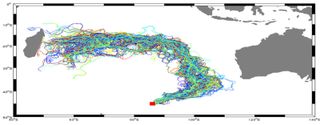
Second, oceanographic drift models simulate the pathways of debris under the action of ocean currents, winds and waves to identify regions where the debris may ultimately make landfall.
These models can also provide timescales for the debris to travel to the western Indian Ocean and this is one of the aspects investigated through our simulations.
Tracking possible debris paths
We used the surface currents predicted by the HYCOM global ocean model as input to a particle tracking model to track debris over a 16-24 month period to coincide with the finding of the flaperon on Reunion Island.
The origin of the debris was specified along the 7th arc at 25 different locations (see top image) extending from the south (-39.258298°S 87.515653°E) to north (-22.815421°S 103.829706°E). For each model run, 50,000 particles were released and tracked over the period March 8 2014, to July 28 2015.
The results indicated that if the debris originated from the southern most location (LOC01 in the top image), the debris would not have reached Reunion Island by July 28 2015 (below).
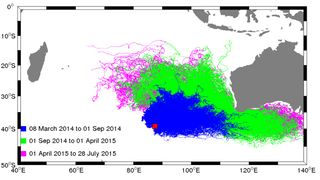
In fact, the debris would not have passed the 60°E longitude; Reunion Island is at 55°E. In contrast, if the debris originated from the northernmost location (LOC25 in the top image), the debris would have arrived at Reunion Island before March 30 2014, some four months prior to the discovery of the flaperon (below).
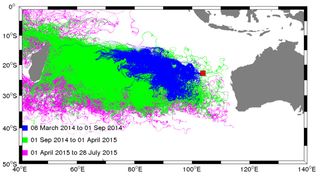
These results are consistent with the finding of the debris in the western Indian Ocean and originating from the 7th arc, but the travel times differ by several months depending on the origin of the debris along the 7th arc.
By examining the time at which the flaperon was found in Reunion Island, the model results may guide us to narrow the locations along the the 7th arc.
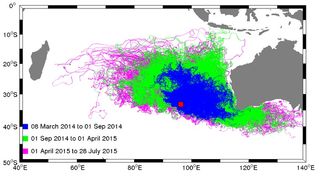
Debris pathways originating from location 11 (LOC11 in the top image) indicated that by July 28 2016, the a first few particles (i.e. the fastest pathway) would have reached Reunion Island (below).
Debris pathways originating from location 18 (LOC18 in the top image) indicated that by July 28 2015, the majority of particles in the time interval would have passed Reunion Island (below).
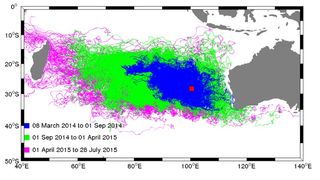
These results from the oceanographic drift modelling indicate that in terms of the timescales involved in the transport of the debris to Reunion Island the most likely location for the origin would be between locations 11 (33.171678°S, 96.294832°E) and 18 (28.297439°S, 100.503580°E).
These results are consistent with recent predictions by an independent Italian group using similar modelling techniques.
So where to search next?
The location of the possible crash site identified through the drift modelling presented here are located to the north of the current sea bed search area.
The current status of the search is that once the current targeted area has been completed, the search is to be suspended. This would allow for careful reflection and review of the different data sources as well as results from the sea bed mapping.
Results of the oceanographic drift modelling indicate that if a new search is to be conducted, then a priority region to target would be the area between 33°S and 28°S along the 7th arc.
Charitha Pattiaratchi, Professor of Coastal Oceanography, University of Western Australia and Sarath Wijeratne, Research Assistant Professor, UWA Oceans Institute, University of Western Australia
This article was originally published on The Conversation. Read the original article.
Most Popular



